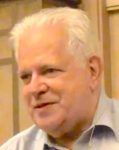by Randy Cima, Ph.D.
The Beginning
My first contact with the psychiatric profession was in 1974. Armed with a new bachelor’s degree in Sociology, I found work as a counselor at an 85-bed boy’s home in Corona, California.
I went back to college at 25 to get a bachelor’s degree so I could become a teacher and coach athletics. I was a good coach. I earned respect from the kids, I treated them with respect, I was in their face just like my best coaches were with me when I needed it, and I tried to help them improve their talents and skills. I liked coaching almost more than playing. Coaching was my style at the boy’s home too, and it was effective.
Dr. Duncan was our M.D. He was a wonderful man. He donated his time, services, and money to the care of these teenage boys. Dr. Duncan was not a psychiatrist. Though there were psychiatric medications available to adults at the time, they were not in common use for children. However, Dr. Duncan found some new psychiatric training available to MD’s regarding some miracle chemicals now available to help children. So, once he was trained, we began to give children chemicals.
Not all of them, mind you. It was the most difficult to manage kids who were given chemicals, the ones the adults complained about the most. The explanation used by the experts at the time was these particular children were hard to manage “because . . .,” and then these same experts would say something vague about brain chemicals and brain parts that didn’t make sense. That’s when this whole idea of magical chemicals began to get fuzzy for me.
How to Stimulate the Already-Too-Stimulated
“What is this Ritalin stuff?,” I asked Dr. Duncan. After all, I was giving these pills to kids, and I wanted to know what they were.
By the mid-seventies, Ritalin was the treatment of choice for hyperactivity, or what was then called hyperkinesis, or minimal brain dysfunction, or minimal brain damage. In the eighties, the term Attention Deficit/Hyperactivity Disorder (ADHD) was coined. In 1987, ADHD was voted-in as a disease in the newest version of the Diagnostic and Statistical Manual (DSMIII-R), psychiatry’s book of diseases.
As a direct care counselor, I used to keep the pill packets in my shirt pocket while managing my group of kids. I handed them out as prescribed, usually after dinner or before bed. The only thing noticeable was that the kids had a tough time going to sleep and were often groggy in the morning. That was explained to me as a “side effect.” I quickly came to hate the term. There was nothing “side” about it. These were full-blown effects.
“It’s a stimulant,” Dr. Duncan replied.
I thought his answer was odd. A few of the boys I was giving it to were arrested and placed on probation because they were using stimulants, usually Benzedrine (“bennies”).
“Why do we give it to kids already too stimulated?” I asked in turn.
This is where it begins to get tricky.
“We don’t know,” Dr. Duncan would say. “It’s what they call a ‘paradoxical effect.’”
This made me nervous. You see, I’m a bit of a skeptic. Skeptics make good scientists and terrible blind proponents. My ears perk up when I wait to hear someone answer a why question, about anything.
To begin with, I wanted to know who “we” and “they” were, and I wanted to know how “we” and “they” know what they say they know. Besides, saying something like “paradoxical effect” doesn’t explain anything. It’s just another way of saying “we” and “they” don’t have a clue.
“But that doesn’t make any sense,” I deplored of Dr. Duncan. “How can a stimulant calm a kid down?”
Seems like a reasonable question, doesn’t it? Why would medical doctors prescribe stimulants to help “perk up” people experiencing excessive daytime sleepiness, and also prescribe them to kids who need to “perk the hell down?” How does a chemical act as a stimulant for adults, and as a sedative for children? How does a chemical know how old someone is?
The reply to these questions, and many, many others? Well, it was the same from all medics and other experts I knew at the time, as I persistently and annoyingly continued to ask. At some point the conversation usually ended with, more or less:
“Shut up and give him the pills!”
I had a degree in sociology. So, I gave them the pills. But I didn’t shut up.
A Very Private Practice
One day a boy had to be taken to the psychiatrist. The doctor’s office called and said there was a last-minute cancellation, and my supervisor picked me to take him to the doctor’s office. I was a little apprehensive. I had pestered this doctor with my questions, apparently to the breaking point. I was nearly 30 by then, I had two daughters of my own, and I wanted clear answers. I don’t do well with platitudes. I guess it showed. At some point he decided he didn’t want to answer any more of my questions, especially when he found out I had a bachelor’s degree in sociology. So, this time I walked in with one of the boys and I quietly found a seat. The boy was soon escorted to a room in the back where he would wait to see the doctor.
It was late in the day and the office was empty. I took a seat just below and to the right of the sliding glass window where the receptionist was. I was extra quiet. After a few minutes, I was out of sight and, as I soon found out, out of mind.
About 10 minutes later, I heard the doctor approach the receptionist area. The receptionist, I would learn, also did the doctor’s billing. Her name was Evelyn. I remember her name because, unbeknownst to the doctor, this is what I heard him say to her, in no uncertain terms:
“Goddammit Evelyn, how many times do I have to tell you?! I don’t get paid for this diagnosis!!”
Hmmm. As I was to learn in the next few years, the love of money really is the root of all evil.
Jimmy
A few years later my wife and I were running an 8-bed facility for teenage boys. We were independent, live-in home parents. We were the child’s counselor, social worker, and therapist all in one. With one of our best friends at the time working on the weekends, the three of us were very successful. We had a work ethic, and the kids were busy around the house. We made sure they got a lot of recreation, we fed them well, we included their parents in the program from the beginning, and, for the first time at this facility, at the end of a year all eight were attending public school. One 12-year-old boy, Rodney, was playing little league, and another 16-year-old, Jimmy, was taking piano lessons. Jimmy was the reason I stopped medicating children.
Jimmy arrived drugged. He was the perfect medication icon. He had been in and out of a number of mental health facilities from the time he was eight, never completing a program and, according to his parents, had just gotten “worse and worse.” He was verbally aggressive, sometimes physically aggressive, but mostly he was defiant. Tell him to go left, and he went right. You get the picture.
One day, after three months at our home, during a common confrontation, I told him to do something or not do something, I don’t know which. It doesn’t make any difference. It’s what adults do with teenagers. He explained his non-compliance to me rather matter-of-factly:
“I can’t help it. I’m hyperactive.”
This bothered me. Though I’d heard it before, this time it was done with what I thought was way too much self-assurance on Jimmy’s part. I think he kind of smiled when he said it. I was caught in the same dilemma as everyone is who adheres to psychiatry’s indefensible and harmful disease model. If it’s really a disease and out of a person’s control, why does anyone expect them to control themselves when you ask them to?
In any event, I replied to his nearly proud declaration, just as matter-of-factly:
“Not anymore.”
With his parents’ blessings and encouragement, we stopped giving him his daily chemical. Over time, with trust, persistence, old-fashioned parenting, educated guidance, family support and Jimmy’s gutsy fight, he improved. So did his confidence. He was cured of a disease he never had in the first place. Despite the cautious and pessimistic handwringing by all the medics who had known him, he was relieved and so were his parents. Now, when he acted like a jerk, he was just a jerk. He wasn’t sick, nor was he “out of control.” He went home to his family nine months later.
I think it went to my head, just a little.
First Date: Meeting a Live Psychiatrist
About a year later, I received a call from the Department Director of the psychiatric hospital at UCLA Medical Center. Pretty big stuff. The doctor said he had a boy, Mark, who has been at UCLA for about four months. Since he heard we had an opening, he asked if I would be available to meet with them to see if Mark would be appropriate for our home. “Sure,” I said, “bring him out.”
Mark was 15 and overweight. He had gained 40 pounds while at UCLA. This was — and is — common in psychiatric settings. There were still some “psyche” hospitals for kids back in the ’70’s and early 80’s in California and I was familiar with several. They all looked the same. Locked doors everywhere, little if any outside recreation areas or equipment — nor the inclination to provide any. There were locked rooms where crafts and groups occurred, always populated by unhappy children and unhappy professionals, all those new medications leading the way. They weren’t treated as kids in these places. God help them, they were treated as medical patients with diseases. They still are.
Mark and his doctor showed up for an interview the next day. The doctor told us about Mark’s history again, and he let us know Mark was clinically depressed. Sounded serious. He told us about what his hospital did, he told us about the professionals there and the papers they’ve written and will write, and in general, overwhelmed us with credentials, experience, and vocabulary. He then told us this:
“Before I forget, Mark is taking 1500 milligrams of Lithium a day because of his depression. I’ll make sure you get his medication and a new prescription until you can get him to your psychiatrist.”
Do 1500 milligrams seem like a lot to you? It did to me. OK, maybe I wasn’t sure what a milligram was back then, however 1500 seemed like a big number. Also, from my point of view, given what I learned about Mark’s family history, it would have been strange had he not been depressed.
And what the hell is lithium?
Lithium is one of the fundamental elements from the Periodic Table. It’s number three, right after hydrogen and helium. In its pure form lithium is the least dense metal, and it’s widely distributed on earth. It’s light enough to float in water. It’s also flammable in certain conditions. Lithium and its compounds are used in heat-resistant glass and ceramics, and its alloys are used in aircraft and batteries. Psychiatric medicine found a use for lithium too, in the form of a salt. More of that at a different place and time. For now, let’s get back to the head psychiatrist from UCLA, Mark, and me.
After hearing his best medical advice, I said to the psychiatrist in a firm yet polite manner:
“We’re going to take him off this medication when he gets here.”
His response was equally polite, as though I hadn’t heard everything he said. So, he repeated himself, explaining again how serious Mark’s disease was, and that he had to be on this medication — probably for life — or there would be serious and dire consequences to his health and well-being. To this I said:
“We’re going to take him off this medication when he gets here.”
This time he was angry and accusatory. He made it clear he did not approve and that it was evident I didn’t understand. I fully expected him to get up, grab Mark, and leave, huffing and puffing his way out the door. He didn’t. He placed Mark with us instead.
So much for his conviction, I said to myself, this medical doctor who was the director of the psychiatric department at UCLA. He placed him with us because Mark was a management problem and he wanted to get him out of his hospital. If he was true to his science, he would have driven him back to Westwood, cursing me as he did. He either didn’t believe what he was saying, or it didn’t matter to him. Either way, we were glad to have Mark in our home.
We took him off his chemicals, with parents’ approval, a few days later. Within four months, he had taken off most of his weight and he fit in with the rest of the kids. There were, of course, the same problems along the way that we had with Jimmy. That’s the nature of the business. We eventually sent him back home to his family a year later.
For the next few years, I was promoted to ever increasing responsibilities. By then, I had little regard for the psychiatric profession and this practice. There were times when I would be training others, and I would steer the conversation to this subject, just so I could say:
“If we gave this many chemicals to animals, the ASPCA would be screaming.”
Chemicalizing children was a growing truth among professionals, and I was out of sync. Nonetheless, I thought the practice was despicable. Most important, I never saw any improvement, in any of the kids, at any time.
To me, this was, and still is, child abuse.
A Keirsey Moment
About this time, colleagues convinced me I should go back to school to get my master’s degree if I wanted to be taken seriously, so I did. By 1979, I started at Cal State University in Fullerton (CSUF). I was going to get my master’s degree in Counseling Psychology and, along with learning new skills, I hoped I was going get to the bottom of the medication thing.
I knew I was enrolling as a small fish from a small pond. It’s one thing to be a little cocky based on self-proclaimed successes. It’s quite another to go into a field where chemicals were being touted as the second coming. I didn’t think I’d fit in, and I knew I wouldn’t be able to keep my big mouth shut. I was a little trepidatious, but fearless.
My first class in my first semester was Counseling 735. It was also the last class for Dr. David Keirsey before he retired from a long career. He had already written Please Understand Me with Marilyn Bates. Since then, he had written several other books, including his seminal work, Please Understand Me II. If you want to understand human behavior, and yourself, read this book. Millions of others have, around the planet.
As the Department Head for the Counseling/Psychology Department at CSUF, Keirsey developed a unique program based on the practice of doing therapy rather than learning the various theories of therapy. He was also a walking bibliography when it came to the history and evolution of human psychology. That made it easy for me. Why go through all the pain of reading this stuff if he already had, I reasoned to myself. Better to see if he had anything worth saying.
Turns out he did. A number of things. A few that changed my entire view of psychology, including an orientation to holistic psychology I will reserve for another time. It was at one of his initial lectures my ear perked for the first time. There were only fifteen of us in the class, so it was comfortable.
He somehow got onto the subject of medicating children. Before academia, he had a career as a child psychologist, working with troubled and troublesome kids in schools and other settings. He had an opinion. He expressed it, and when someone pressed him as to what, exactly, did he mean, he turned, looked at his student, and declared:
“I said I think it (the practice of medicating children), should be criminalized.”
Did I just hear him right? Did he just say giving these chemicals to children should be against the law? Yes he did. I sat up in my chair. He didn’t sound at all like the doctor from UCLA. If I was hearing him right, he would have had him locked up. This was affirming. Though he was unknown to me, this was Dr. David Keirsey, Clinical Psychologist, and the head of the Counseling/Psychology Department at Cal State Fullerton.
But it wasn’t just that. I’m not so easily impressed by credentials or experience. Fools often have the right credentials and experiences. I had met a lot of them already. No, it was that there were voices out there in the professional world who had long ago came to the same conclusion as I. This was just the first time I heard it. This meant my views had professional merit.
By 1983, I was immersed in my Master’s program. I took work as admissions director and child-care trainer at a 120-bed agency in Southern California. I did many workshops about strategies and techniques in child management, and I always folded this subject in, indicating the practice was (1) unproven, (2) ineffective, (3) detrimental to children, and I would list the evidence for each. I was not persuasive, and I still had that damn degree in sociology.
It didn’t matter. No one was paying attention anyway. The chemical wave had started.
The APA
Around this time, I was sitting in a barbershop on a Saturday morning, waiting my turn. I was thumbing through a psychology magazine. I ran across an article written by someone from the American Psychiatric Association. The APA is a member-based lobby group for psychiatrists.
Back then psychiatrists were still doing therapy while their client was on a couch, staring at the ceiling, and disclosing his or her most private thoughts and feelings. Troubled adults went to their psychiatrist to talk about their troubles, and the relationship they had with their doctor was very important. These chemicals were intended to be an addendum to the real therapy that took place in a quiet office for an hour. After all, a psychiatrist is first an MD, and if there are chemicals available to ease physical discomforts and complaints, they could be used with certain clients so the therapy in the office could continue with better results.
However, the article’s author, also a psychiatrist, was concerned a growing number of his colleagues were relying way too much on these new chemicals. He warned too many psychiatrists were abandoning more traditional forms of therapy, succumbing to the appeal of prescribing chemicals to treat psychiatric disorders. In doing so, they were minimizing, and sometimes eliminating, traditional talk therapy sessions. As important, said the writer, the financial incentive was undeniable. Many psychiatrists were doubling their income, with much less work. The profession, the author feared, was turning away from psychology and towards medicine when it came to helping their clients with persistent life problems. The tone of the article was cautious and meant to discourage their members from getting too far from the couch.
Unfortunately, it didn’t take.
A Little While Later . . .
Now, quickly, roll the clock forward 15 years. By 1999, I was the Executive Director for a new wraparound program working with children still living at home with their families. We had a contract with a county Mental Health Department in Southern California. Though we were an independent, private, nonprofit agency, the contract required all agencies to defer all medical decisions to the county psychiatrist. The treatment plan for any adult or child in the mental health system in California is required to be reviewed and approved by a psychiatrist. Funding depends on it. No psychiatric overview, no funding.
I attended a weekly treatment meeting that included my staff, several other non-profit agencies and their staff, and the staff from the Mental Health Department (no clients). The psychiatrist sat at the head of the table while therapists from each program reviewed the progress for their most troublesome clients. Based on this information the psychiatrist would increase or decrease the amount of a current chemical, leave it the same, or change the chemical to something more effective.
One day, a therapist from another program was exasperated. Her client was not improving, and in fact was getting worse. With the best of intentions, and a little desperate, she was looking for support and assistance, so she asked the psychiatrist:
“Would you mind talking to my client yourself, just to see what you think?”
My ear perked, again, like it always does when something interests me. I wanted to hear his answer. I thought it put him on the spot and I didn’t mind him squirming a bit. Regrettably, once again in my career — you’d think I’d learn — I underestimated the implied supremacy that accompanies all psychiatrists, and their proponents. In an angry, frustrated, and accusatory tone, he replied to this young, uninformed therapist, and everyone else in the room to boot, slamming the palm of his hand on the table for emphasis as he did so (and beginning the short rant with the same expletive as the first psychiatrist!):
“Goddammit!! When is everyone going to finally understand?! Psychiatrists prescribe meds!! That’s it!!”
Game Over
And that was it.
He made it official. There was neither need nor inclination for anyone to pretend psychiatrists did anything else. In just 15 years from the time I read that cautious APA article, the author’s concern had been addressed and firmly answered in the profession. Nationwide, psychiatrists had hauled their couches to the curb, got a lifelong supply of prescription pads, and became engaged in their work by prescribing chemicals for every human shortcoming known, fully prepared for next year’s crop of new diseases — making a fortune while doing so.
Talk therapy was demoted to others without prescriptive powers. Without anyone’s notice, talking directly to the client for an hour about his or her problem was no longer necessary and, by some, frowned upon in the revised Scope of Practice of modern-day psychiatrists. The relationship between patient and psychiatrist was no longer relevant.
I knew by then there was a small but growing number of professionals who saw this for what it is: a vast marketplace worth a hundreds of billions of dollars a year worldwide, and a remarkable era on earth when well-meaning adults give harmful chemicals to children for diseases they don’t have, blessed by the vast majority of citizens in the United States. That means most of you.
I’m not a novice anymore. Along the way, I’ve learned all about Neverland, and the pseudoscience of psychiatry, and I know their results.
So will you.

Randy Cima, Ph.D., is a psychologist by training. He was the Executive Director for several mental health agencies for children. He is avid opponent of psychotropic chemicals for children, and his efforts have successfully reduced and even eliminated chemicals in his work in helping them with a variety of problems. He also teaches, writes, and lectures on these matters.
 Randy Cima, Ph.D., is a psychologist by training. He was the Executive Director for several mental health agencies for children. He is avid opponent of psychotropic chemicals for children, and his efforts have successfully reduced and even eliminated chemicals in his work in helping them with a variety of problems. He also teaches, writes, and lectures on these matters.
Randy Cima, Ph.D., is a psychologist by training. He was the Executive Director for several mental health agencies for children. He is avid opponent of psychotropic chemicals for children, and his efforts have successfully reduced and even eliminated chemicals in his work in helping them with a variety of problems. He also teaches, writes, and lectures on these matters.
 Niall (Jock) McLaren is an Australian psychiatrist who recently retired after 50 years of practice. He has extensive experience in military, forensic and remote area psychiatry, all at the rough and unglamorous end of psychiatry. As a specialist, he went back to university to study philosophy and has published a number of monographs on the application of the philosophy of science to mental disorder, most recently brought together as the biocognitive model for psychiatry. This is based in the concept of natural dualism, and provides a working model for mental disorder as a primary psychological matter, with no reason to suspect brain pathology. He lives in the rural outskirts of Brisbane with his family and keeps busy growing trees.
Niall (Jock) McLaren is an Australian psychiatrist who recently retired after 50 years of practice. He has extensive experience in military, forensic and remote area psychiatry, all at the rough and unglamorous end of psychiatry. As a specialist, he went back to university to study philosophy and has published a number of monographs on the application of the philosophy of science to mental disorder, most recently brought together as the biocognitive model for psychiatry. This is based in the concept of natural dualism, and provides a working model for mental disorder as a primary psychological matter, with no reason to suspect brain pathology. He lives in the rural outskirts of Brisbane with his family and keeps busy growing trees.

 Todd DuBose, Ph.D., is an award winning Distinguished Full Professor at The Chicago School of Professional Psychology, as well as a licensed psychologist with over twenty years of teaching, supervising, and consulting experience, and over thirty years of clinical experience, including nine years as a former chaplain at the famed Bellevue Hospital in New York City. He holds degrees in contemporary continental and comparative philosophy of religion (B.A., Georgia State University; M.Div., Union Theological Seminary, NYC) and in human science clinical psychology (Ph.D., Duquesne University). He integrates these traditions in an existential-hermeneutical-phenomenological way of caring for others, specializing in extreme, limit or boundary events and their accompanying crises of meaning (e.g., violence, loss, trauma, psychosis, nihilism). He teaches regularly in international venues and has done so in twelve countries. His research and scholarship also focus on critiques of implicit biases in foundational ideologies of standardized practices of care, particularly the medical/disease model of engineering existence, that can intentionally or unwittingly harm others in the name of care. He is committed to the engaged practitioner, public scholar practice of community engagement and advocacy.
Todd DuBose, Ph.D., is an award winning Distinguished Full Professor at The Chicago School of Professional Psychology, as well as a licensed psychologist with over twenty years of teaching, supervising, and consulting experience, and over thirty years of clinical experience, including nine years as a former chaplain at the famed Bellevue Hospital in New York City. He holds degrees in contemporary continental and comparative philosophy of religion (B.A., Georgia State University; M.Div., Union Theological Seminary, NYC) and in human science clinical psychology (Ph.D., Duquesne University). He integrates these traditions in an existential-hermeneutical-phenomenological way of caring for others, specializing in extreme, limit or boundary events and their accompanying crises of meaning (e.g., violence, loss, trauma, psychosis, nihilism). He teaches regularly in international venues and has done so in twelve countries. His research and scholarship also focus on critiques of implicit biases in foundational ideologies of standardized practices of care, particularly the medical/disease model of engineering existence, that can intentionally or unwittingly harm others in the name of care. He is committed to the engaged practitioner, public scholar practice of community engagement and advocacy.